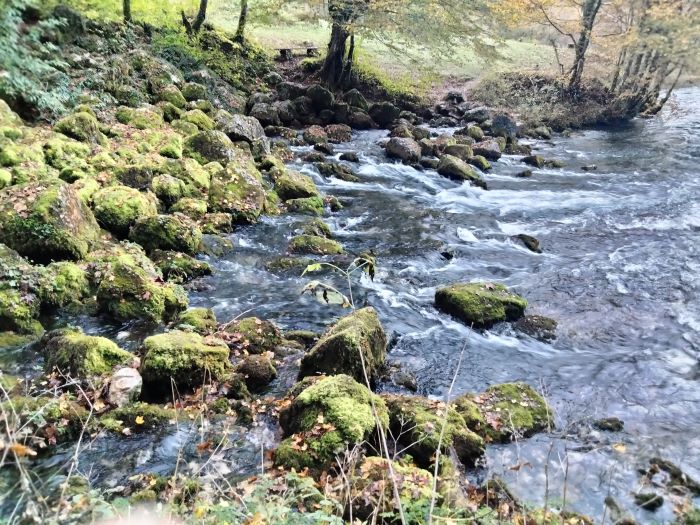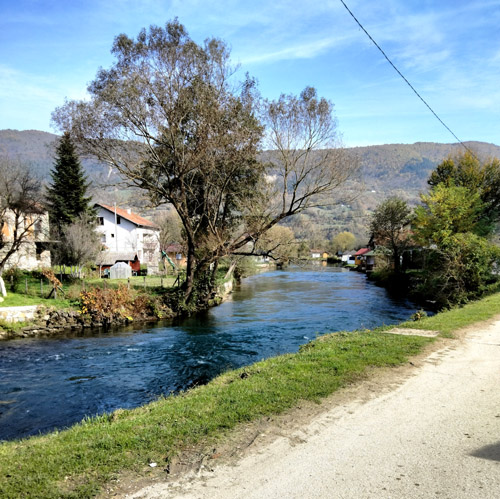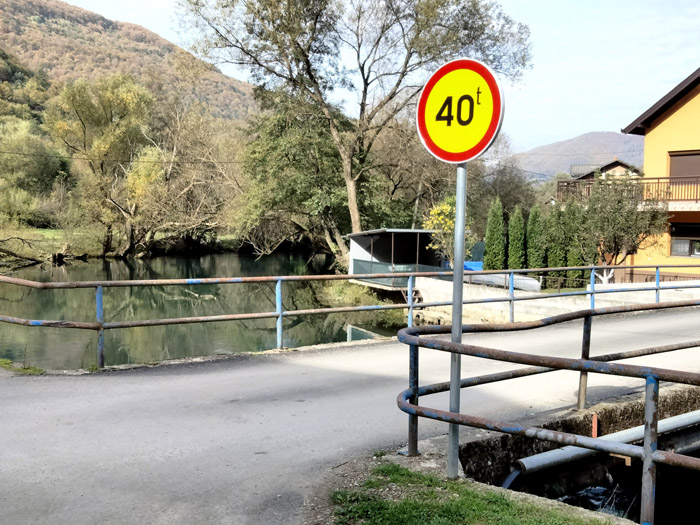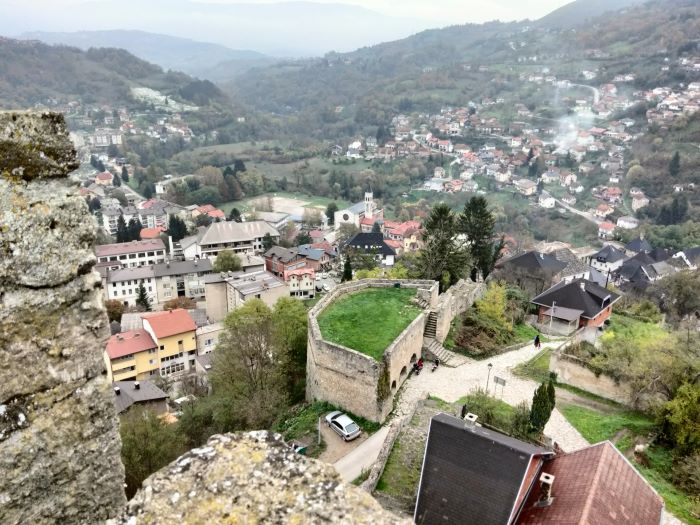Bosnia journals 2024,
Journal #3:
The Pliva River, from the headwaters to the Jajce waterfalls
2024 Journal
index
Introduction: Meeting the environmental activists
Journal 1:
Ozren is Not for Sale
Journal 2: Pecka
and vicinity: biologists on front line; scandal of coal
Journal 3: The
Pliva River, from the headwaters to the Jajce waterfalls
Journal 4: Coal in Ugljevik; Lithium on Mt. Majevica
Journal 5: With Hajrija Čobo at Mehorić;
Visiting Robert Oroz in Fojnica
Previous journals and articles
To contact Peter in response to these reports or any
of his articles,
click here.
|
Peđa
Gajanović works at the Pecka Visitor Center. He grew up in Šipovo,
and was too young to be dragged into the war. Before the war, the
towns in that municipality were ethnically mixed, but predominantly
Serb-populated. Šipovo was taken over by Bosnian government forces,
but at the end of the war, the 49% - 51% territorial deal made at
Dayton granted the town to the Republika Srpska. Displaced Serbs
returned, including Peđa's family, and a small number of Bosniaks
stayed. In Šipovo as in nearby Jezero, relations between the two
ethnicities are relatively calm. There is much travel, often for
work, across the nearby inter-entity boundary. Jajce is not far away
in the Federation.
On my last day at Pecka, Peđa
gave
me a tour of the headwaters of the Pliva River. We drove through
Baraći village and south towards Dragnić, which we had surveyed from
the viewpoint high on Mt. Vitorog the day before. Not far from
Dragnić, Peđa took me to a forest where one of the sources of the
Pliva was located. We walked along a path through the trees by the
river—at that point little more than a brook—until we came to a
place where water was bubbling out of the ground at the bottom of a
wooded hillside, across an expanse of several dozen meters. This was
the source.

Source of the River Pliva
Peđa
mentioned five rivers that converge at his hometown: the
Pliva, Janj, Sokočica, Lubovica, and Volarica.
As we
walked, he dipped a bottle into the clear water and handed it to me,
proud of the "most drinkable water in Europe."
Other than that water, Peđa remembers much that is not clean,
sharing his memories of the war and what has happened in the area
since then. There were priests who sold blessings to their
followers; the priests competed with each other for territorial
rights. During the war, there were Serb "businessmen" who sold
automatic weapons to the other side. And now, local politicians buy
votes in different ways. One of their favorites, Peđa says, is to
asphalt roads shortly before an election. "They lay asphalt as thin
as a palačinka," he said, referring to the crepe-like local
delicacy. "The
asphalt they lay is twelve centimeters thick, and they rake money
off the top of the tendered contract. It is not unheard of for them
to lay a road to a village where there are only five people."
Peđa described his life as a young teenager, when his family
returned home to Šipovo. The place was lively with British UN
troops, officials, and NGO workers. "UN doctors provided free health
care to everyone. Then, in 2005 they left to go to Iraq and
Afghanistan. After they all left, the shops were closed."
Peđa leaned toward punk culture and journalism. He tried to operate
a game center, but clientele diminished as younger people steadily
departed for Europe. He got a job working at the bentonite factory,
and stayed for 18 years. More recently he started volunteering at
Pecka, and was eventually employed there. He fits in temperamentally
with the environmentalist, preservationist, and anti-industrialist
ethic of the place. He showed me this simply by taking me to the
places of his heart, the woodsy spots where the Pliva divides, flows
around river islands, and reunites at the other side.
*
From Pecka I traveled to the small town of Jezero (Lake), located
northeast of Šipovo along the Pliva River, just before the river
leads into Plivsko Jezero, Pliva Lake. The lake is bisected
by the inter-entity boundary, not far from the town.
I met Mumin Keljalić at Abba, a kafana on the main road between
Mrkonjić Grad and Jajce.
During the war, Mumin took refuge in Sarajevo; now, he spends his
time between Jajce and Jezero, where he has family ties. Before the
war, he said, Jezero was part of Jajce municipality, but now it is
in the RS: "We used to live normally together, with Croat villages,
Muslim villages, and Serbs. But then, they killed 57 Muslims here.
It was a political act."
Mumin told me that in 1992-1993 the "Bosniak population all left, to
Switzerland, to Florida. They come back in the summertime. The older
people come to visit, but not the younger ones. There are 5,000 or
6,000 Bosnians from this area who now live in Sweden."
I asked if people live peacefully together. "Of course," he
answered, "People never had a problem. Many people from here are
working in Jajce. And many people from Jajce work in the restaurants
at the source of the Pliva."
People broadly ignore the artificial inter-entity boundary. "In May,
we had a bike ride from Jajce to Pljeva
[located in different entities], and
about 300 people participated. They came from all over
Bosnia-Herzegovina." The unparalled natural beauty, away from the
larger cities, was the attraction.
Mumin is a retired mechanical engineer and a seasoned environmental
activist, a couple of years older than me. At his age, most people
in Bosnia-Herzegovina are living a quiet life, but Mumin is fit and
active, looking a good 15-20 years younger than his age. I attribute
this to his closeness to nature; he owns three canoes, and the water
is just outside his front door. "It is paradise on earth here," he
said, adding, "I
have been rafting all over the region. And when I'm tired, I just
take a spin on the river, and I feel refreshed. But it was nicer
when more people lived here; now, there is no one."
Plivsko Jezero is 3 kilometers long. "You can kayak there, canoe,"
Mumin told me, "It's the best place in the world. There's also the
artificial late Bočac. Matije Ljubek trained here: he was the
Olympic champion in kayaking many times."
Turning to the incursion of foreign industrialists, Mumin told me
that Lykos Metals started exploring for lithium in the area in
2020-2021. He pointed to a place just about 300 meters from Abba
where there had been prospecting, along with several other places.
"The companies go where there is less resistance. They were looking
for lithium and cobalt, which are found naturally in combination."
Mumin said that Lykos had received a permit for exploration but, for
the time being, the company is inactive in the area. "If there is
full-scale mining," he told me, "it will be a catastrophe. They will
create a desert out of this place."
The area around Jezero has received attention from environmentalists
around the country, due to the threat of mining—especially of
lithium—by Lykos. Local activists formed the Association for Pliva
Valley, and prominent activists such as Hajrija
Čobo from Kakanj, and Lejla Kusturica of the Sarajevo
environmentalist Foundation ACT—Atelier for Community Change—have
visited to express solidarity.
Mumin discussed the behavior of Jezero's mayor Snežana Ružičić, now
in her second term. "During
her first mandate," he said, "she was ok. But now she has started
pulling deceitful moves and targeting environmental activists. She
is with SNSD, Dodik's party. Take a look at her instagram account;
she comes across like a starlet. In her recent re-election campaign,
there was electoral engineering. Ružičić gave away bags of flour to
voters. She entered into the polling stations illegally. She won the
election by just a few votes. "
During Tito's time, Mumin told me, the government built two bridges
across the Pliva at a place in the middle of the town of Jezero,
where there was a small island to traverse. The bridges were both
rated for a load of 12 tons. In 2023, he says, Ružičić summarily
changed the signs to read 40 tons, without any modification to the
bridges. "People are worried that the bridges will be destroyed by
the heavy trucks that cross them.
I asked what the trucks were carrying: ore and tailings from
prospecting. "The
people rebelled," Mumin told me, "and the police can't prevent
anything. We had two big protests in 2022. Then, the mayor targeted
us, and had us blocked on Facebook. Lykos is not active now, but
gold,
lithium and bauxite have been identified in the area. So
we never know what's going to happen."

The Pliva as it flows through the town of Jezero
Mumin drove me around the town. We crossed the two mis-rated
bridges. As we drove along the river, he pointed out the
deteriorating road, cracked from the weight of the heavy trucks. He
gestured to a row of houses, telling me that they were all looted
and burned at the beginning of the war, in the summer of 1992. Now
they have been repaired, but he pointed to houses one by one, saying
that the people who own them have gone to Turkey, Australia,
Florida, Pula, Bulgaria, Sweden, and Canada. There are visitors and
temporary returnees all summer.

A 12-ton bridge "re-flagged" at 40 tons
Large and small hydro-electric dams are a worry to everyone who
loves the rivers in these parts. Mumin mentioned Ugar dam, east of
Jajce on the inter-entity boundary, near Ilomska waterfall. The Ugar
flows along the boundary, on the Federation side for a while until
it merges with the Vrbas in the Republika Srpska. There were several
additional dams built or planned on the river. One was built ten
years ago at Zapeće and another at Novakovići.
Construction of another mini-dam was started at Ostrač three days
before a moratorium on the building of small dams went into effect
in the Federation in 2020. In response to environmentalists'
appeals, the Federation's High Court
revoked the building permit
in late 2023.
The
prohibition
against new construction of mini-dams was passed without opposition
in July of 2022 in both houses of the Federation parliament. This
was the result of more than ten years of active resistance by
defenders of the river under the umbrella of the
Coalition for Protection of the Rivers of
Bosnia-Herzegovina
(Koalicija za zaštitu rijeka Bosne i Hercegovine). Members include
fishing clubs, tourism associations, environmentalists, and local
communities. The law prevented the subsequent construction of 100
small hydro-electric dams in the Federation (larger dams are another
matter)—but no such measure has been passed in the Serb-controlled
entity.
Mumin
continued on the subject of Ugar: "They use big pipes there, and the
dam takes away so much water that they had to decommission other
dams because of lack of water.
It is a catastrophe. The animals are left without enough water. But
around Jajce, there are many brooks, and the politicians want more
dams. I predict that the dams they have already built will fall
apart, because they are not being maintained."
In late 2021 activist Indir Melić
reported
that, with two dams already operating on the Ugar, the flow of the
river was already reduced to one third of its original volume, and
that the climate along the river had been altered, leading to the
disappearance of plant and animal life: "Even the surroundings of
the river are no longer the same; the lush flora has been replaced
by gravel and concrete....the Ugar is now at a biological minimum."
I have gone into detail about the problems with mini-dams on the
Ugar River not because it is a special case, but because its
situation is representative of many of the
262 rivers
that flow through Bosnia-Herzegovina. Few of them are not
endangered. There are already 33 mini-hydro-electric dams just in
Central Bosnia Canton (Srednjobosanski kanton), where Jajce, Travnik,
Bugojno, Fojnica, and Donji Vakuf are all located. Construction of
most new mini-dams has halted in the Federation, but dozens more are
still planned in the Republika Srpska.
As with coal mining, the construction of mini-dams enriches a few
and, while impoverishing the environment, it provides little or no
benefit to the citizens.
Interenergo d.o.o. Sarajevo, which
controls numerous dams, has a net income of nearly 36 million KM. On
average,
exactly one person
is employed at each of the company's dams.
It is the powerful politicians at the local, entity, and state level
who benefit from the construction of the dams. Indir Melić
commented,
"That energy lobby is strong, and we know who stands behind it.
Those are mainly former and present politicians who prepared the
ground for this kind of thing, reaping the rewards of their
misdeeds—that is, of their criminality—because destroying nature is,
in my opinion, a criminal act. Those are the Selmans, the
Bičakčićes,
the Erlagićes, Kasumovićes, and the rest of them. It is very clear
who stands behind those hydro-electric dams." Melić listed a roster
of some of the most well-known and prominent leaders of the postwar
period.


The waterfalls at Jajce
From
Jezero I traveled the short distance to Jajce. Crossing into the
Federation, I rode along Plivsko Jezero and, from there, followed
the Pliva River into the beautiful medieval town. Jajce changed
hands twice during the war, first taken by Serb forces, which
resulted in the displacement of most Croats and Bosniaks. Late in
the war, Croat forces retook the city. Jajce came under Croat
nationalist control, but there was significant return of Bosniaks
after the war.
The numbers of Croats and Bosniaks before the war and at the time of
the 2013 census were nearly in the same proportion, although both
communities have been reduced by emigration. There is no accurate
count for the present population of Jajce, but informal estimates
say that it is around 15,000, down from a pre-war height of 40,000.
One person told me, "Most
of our older people are seeing their grandchildren via cell phone."
Much of the pre-war Serb population left during the war and did not
return. Although Croat nationalist signage and symbolism are evident
in the center of town, tension between ordinary Croats and Bosniaks
is low.
Jajce is notable for its UNESCO-proposed World Heritage Site, the
waterfalls that grace the very center of town. Below the waterfalls,
the Pliva joins the Vrbas on its way to the Sava River, at the
northern border between Bosnia and Croatia. Jajce is also the
location of a well-preserved medieval fortress on top of a steep
hill right in the center of town. Important events also took place
in Jajce during World War II, when a provisional government led by
the Partisans officially founded the Federal Republic of Yugoslavia.
Since the 1990s war, the town's economy has primarily depended
on tourism.

View of Jajce and beyond, from the Ottoman
fortress
In
Jajce I met with Velid Hrnjić, a long-time environmental activist
about 60 years of age. He told me, "I
started out in tourism, but I became a stone and ceramic installer.
I'm happy when people call me majstor [craftsman]." After the
war, Velid's love for his town and its natural surroundings led him,
first, to participate in the restoration of a damaged hikers' cabin.
From the coffee house were we were sitting, he pointed out the hill
where the cabin was located. "This is how I started getting involved
in environmental activities. Then I started leading the group.
"In our first environmental radna akcija (work action), we
rebuilt the small, antique watermills ("mlinčice") at the entrance
to Jajce. We arranged for cabins to be placed nearby, for tourists
to stay overnight. One of the mills still works, for show. Then,
there was a flurry of actions. We participated in an international
campaign, 'Let's do it,' where each citizen would clean up one
square meter. In 20 years of activity, we have come to an
understanding of how to do things."
I asked if there was multi-ethnic
cooperation on projects. Velid answered, "Yes, because we all need
clean air and water. The health of the environment is in everyone's
mutual interest. We have gathered NGOs to work together, 50 of them,
including sports groups."
Another project on Ćusine, the same hill where the hikers' cabin was
rebuilt, involved mobilizing people to prevent clear-cutting. Velid
pointed out that there is just a thin layer of soil under the trees
in that forest. Removing the trees would have turned that hill into
a place of landslides and flooding. "We stopped the cutting with a
barricade," Velid said. "This was in 2012. We also organized
academics from all around the country, and got them to call for a
stop to the whole thing. We drew up a petition with 12 conclusions.
We got support, including from the mayor. The forestry department
had to stop work because of public pressure. That is how we learned
to solve these problems." Velid concluded, "That land is a zelena
učionica, a green classroom. It is now protected."
The victory in the struggle to protect the forest on Ćusine was
finalized in 2020. "Now there are new problems," Velid said. "We
have a petition against a new dam. I found out by chance about the
idea for a dam above the Jajce waterfalls."
I remarked that a dam in that placement would destroy the
waterfalls. "Everyone who is normal knows that. But this is a land
of corruption and crime," Velid answered. "The SDA [the governing
Bosniak nationalist party] had contracted with a construction firm
in Sarajevo that had connections here. When I found out about this,
I called 40 people together. This was during the Corona outbreak, so
that was the limit to a gathering. We contacted environmental
experts, who said that the dam would be a catastrophe for waterfalls
and tourism.
"We met just after the elections, but the government had not been
formed yet. The dam project required the agreement of the city
council, but it had not yet been formed. There was a rule that if
there was no answer to the proposal within 30 days, that constituted
a 'yes.' It was a sly tactic on the part of those proposing the dam.
But then, we were clever. We got in touch with a municipal council
member, and petitioned for a delay to that decision. We were
successful; local opinion was key. This campaign was part of what
led to the banning of new dams in the Federation. This has all been
achieved by getting the citizens together."
Velid discussed further endangerment of the Pliva leading into Jajce,
and the machinations of regional leaders. "Technically, the mayors
of Šipovo, Jezero, and Jajce each committed to securing the
integrity of the river. They agreed to stop building dams. But the
absurdity is that after that, they started planning the concrete
lining of the river, and they planned new dams around Šipovo."
I had heard that the mayor of Jajce was not pro-environment. Velid
said, "When there was much public pressure, he was good. But if you
dig a little, you see connections between the mayors, the
construction companies, and the Sava River Basin Agency (Agencija za
vodno područje rijeke Save)." Velid elaborated on these ties, but
cautioned, "We know details, but we have to be careful. I could get
in trouble; we have to document everything.
"The cronyism and criminality are as clear as day, but hard to
prove. This is all because of personal interest. And there are many
projects being implemented without even environmental studies being
conducted. We heard the head of the River Basin Agency on the radio
with the mayor. In response to our protests, they were saying,
'These rebellious people don't have the elementary knowledge.'"
This recalls the law that the Republika Srpska Parliament passed in
the last year rendering it unnecessary to consult local communities
regarding mining and other projects that have environmental impact.
"Now, Đokić [RS Minister of Energy and Mining] can decide on local
projects without local consultation. That is the danger. In the
Federation the public can create pressure, but not in the RS," Velid
told me.
I asked if there was exploration for minerals going on in the area
around Šipovo and Jezero now. Velid said, "It has stopped, but it
will start again. Experts say that mining in Jezero will destroy the
Pliva, and it will wreck tourism and the drinking water. We have
planned a civil initiative from all three municipalities to protect
the Pliva. This is not political; it is mutual interest. When you
throw something in the river in Jezero, it is here in one hour. We
are engaging experts, not just saying 'I'm against it.'" If 90% of
the people are in favor of protecting the river, then the government
must listen. But the question is how to organize. The people do not
know how much power they have."
*
Just before leaving Jajce I met with Samir Beharić, a young scholar
and environmental activist. Samir is involved in the same
environmental resistance as Velid. He noted that there had been two
different proposals to build dams on the Pliva: "One was in the
city, near the Unesco heritage site. It would have killed the
waterfalls and Plivsko jezero. We examined the project plan: it
turned out that it was gibberish. It was a copy of a plan in Tuzla;
Two thirds of the data was from Jajce, and one third from the Tuzla
plan. It even mentioned areas near Tuzla.
"We took screenshots of the plan and sent it to the N1 Bosnian news
agency, exposing the mayor. The promoters of the project said that
there were 'typographical errors.' People were angry at that,
saying, 'Someone is lying to us; they think we're stupid.' Radio
Free Europe quoted me as saying, 'They will be more likely to dam
the Danube at Vienna than the Pliva at Jajce.'"
Samir described the intensive pressure campaign to get 7,000 people
to sign a petition against the dam; it was "unpopular," he said, not
to sign the petition. All the municipal council members signed
except for the mayor. Organizers went to the church on Sunday and
everyone including the friars signed; when the imams saw this, they
and their congregations signed as well. "The city council understood
that the majority was opposed to the dam. It was not politically
sexy to support it."
Samir summed up the dynamics of the campaigns around Jajce saying,
"Here, civil society is rich, vibrant; there are active NGOs led by
experienced activists. They are very sensitive to environmental
problems. This is about the perception of power."
When the leaders see that the community has mobilized, they can be
moved. But they will drag their feet. "The ministries have been
ordered not to talk to activists," Samir commented, "and there is a
kind of criminal entropy. In Jezero, mayor Snežana Ružičić brought
Lykos in."
Furthermore, Samir describes the position of Bosnia's fragile
environment in international dynamics: "What concerns us is that the
EU, the US, and others, are benefiting from corruption. They can
bring companies here to exploit loopholes or just break laws in ways
they could never do in their own countries."